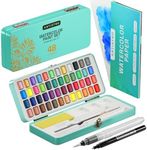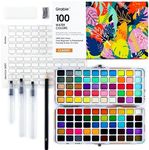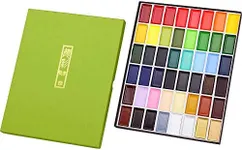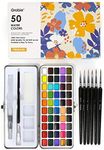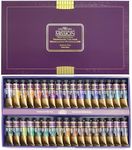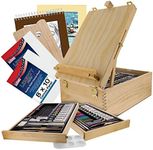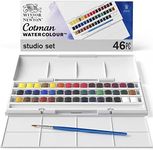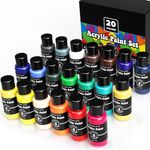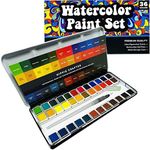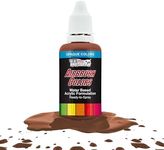Buying Guide for the Best Watercolor Sets
Choosing the right watercolor set can be a delightful yet overwhelming experience, especially with the variety of options available. The key to finding the perfect set lies in understanding your needs and preferences, as well as the specific features that different sets offer. Here are some important specifications to consider when selecting a watercolor set, along with explanations to help you make an informed decision.Color RangeThe color range refers to the number of different colors included in the set. This is important because a wider range of colors allows for more versatility and creativity in your artwork. Watercolor sets can range from basic sets with 12 colors to professional sets with 48 or more. If you are a beginner, a smaller set with essential colors might be sufficient. However, if you are more experienced or want to experiment with a broader palette, a larger set with more colors would be beneficial.
Quality of PaintThe quality of watercolor paint can vary significantly between student-grade and artist-grade sets. This spec is important because higher quality paints generally offer better pigmentation, transparency, and lightfastness (resistance to fading over time). Student-grade paints are more affordable and suitable for beginners or casual use, while artist-grade paints are ideal for serious artists who require the best performance and longevity in their work. Consider your level of expertise and how important the quality of your finished pieces is to you when choosing between these grades.
Type of PaintWatercolor paints come in different forms, including pans, tubes, and liquid. This spec is important because each type has its own advantages and is suited to different styles of painting. Pans are compact and convenient for travel, making them great for plein air painting. Tubes offer more paint and are easier to mix, which is ideal for larger works or more intensive use. Liquid watercolors are highly concentrated and can be used for vibrant washes or detailed work. Think about where and how you plan to paint to determine which type of paint will best suit your needs.
LightfastnessLightfastness refers to how resistant the paint is to fading when exposed to light over time. This is important if you want your artwork to maintain its original appearance for years to come. Paints with high lightfastness ratings are less likely to fade, making them a better choice for professional artists or anyone creating work intended for display. If you are painting for practice or short-term projects, lightfastness may be less critical. Check the ratings provided by the manufacturer to ensure the paints meet your longevity requirements.
TransparencyTransparency is a characteristic of watercolor paint that allows underlying layers to show through, creating depth and luminosity in your artwork. This is important because it affects the overall look and technique of your painting. Transparent paints are ideal for layering and glazing techniques, while opaque paints can be used for more solid coverage and highlights. Consider the style of painting you prefer and whether you need more transparent or opaque colors to achieve your desired effects.
Packaging and PortabilityThe packaging and portability of a watercolor set can greatly influence your painting experience, especially if you plan to paint on the go. This spec is important because a well-designed set can make it easier to organize and access your paints. Compact sets with built-in palettes and brush holders are convenient for travel and outdoor painting. Larger sets with separate palettes may be better suited for studio use. Think about where you will be painting most often and choose a set that offers the right balance of convenience and functionality for your needs.
